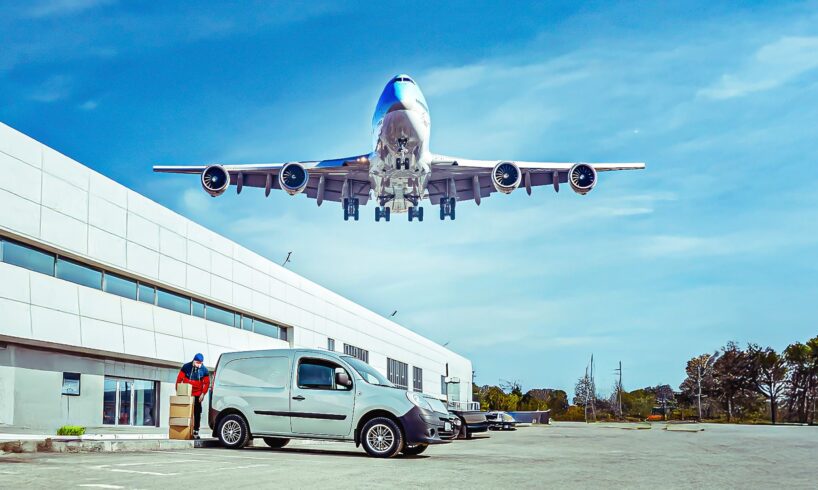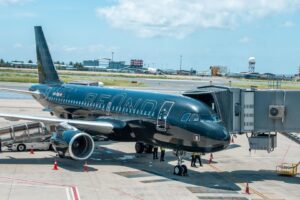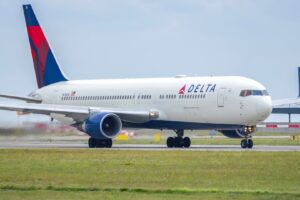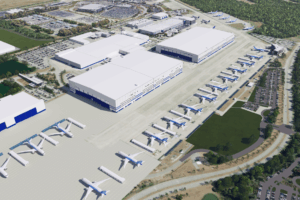
The overwhelming majority of the 155 double-decker 747-8s that Boeing made were put into service as cargo freighters, and the few passenger carriers that did go into service were all sold to carriers overseas. The Boeing 747 is a legendary plane in American aviation history, and some of the most revered names in the airline business flew it as their flagship for many years. If the jumbo jet was the central figure in American flying culture, why did its final version fail to sell to any domestic carriers?
Stock Code
BA
Business Type
Planemaker
Date Founded
July 15, 1916
CEO
Kelly Ortberg
Headquarters Location
Chicago, USA
The 747 made history when it debuted, airlines clamored to get their own, and the many air carriers of the United States put them into service on their most high-profile routes as soon as they arrived on the flightline. The -8 was produced between 2008 and 2023, a 15-year manufacturing run. In all that time, not one ever rolled out of the factory doors in a US airline’s livery. The cause simply came down to economics, as twinjets like Boeing’s 777 offered a more profitable option. The last 747-8 ever made was a cargo hauler, handed over to Atlas Air.
Pan Am And Its Last 747s
Photo: T Jerkson | Flickr
Pan Am was famed for its glamorous service, and a large part of that luxurious travel experience was provided by the 747. Pan Am was the launch customer when Boeing first introduced the 747, but the airline didn’t survive long enough to see the final model take flight. As the era of deregulation saw airlines in the US falling like dominoes, so did Pan Am. The once great Pan American World Airways declared bankruptcy in 1991.
The Los Angeles Times reported that Chairman Thomas G. Plaskett said the Persian Gulf crisis has caused Pan Am’s fuel expenses to rise by $150 million over the months leading to the company’s shutdown. He claimed that both leisure and business travel were impacted by the economic downturn. Additionally, a hijacking that ended in the destruction of Pan Am Flight 103 over Scotland in 1988 had caused a “heavy toll on our cash flow,” as he said.
Many attribute at least some of the cause for Pan Am’s insolvency to the airline’s reluctance to part ways with the jumbo jet. The “Queen of the Skies,” as the 747 was often called, was intertwined with Pan Am’s brand identity and company culture, which made it difficult for the company’s leadership to chart a new course without it. Pan Am also faced a lawsuit of $300 million, after its 747 was bombed and was subject to multiple safety fines imposed by the Federal Aviation Administration (FAA).
Related
The Aircraft Replacing The Boeing 747
As Boeing’s flagship, the Boeing 777X is the closest thing to replacing the Jumbo, although it is not a direct replacement.
Last Of A Dying Breed: The 747-8’s Fate
Photo: Dave Subelack | Wikimedia Commons
Today, a handful of 747-8I models still cruise the skies, hauling international travelers around the globe. The “I” in 747-8I stands for “intercontinental,” and that’s exactly the kind of flying most of the remaining jumbos are doing today. They are all eventually slated to be replaced by Boeing’s new 777X or Airbus A350 widebody twinjets, but for now, at least, the iconic double-deckers are still gracing our sky as they soar between continents.
Lufthansa,Korean Air, and Air China are among the few airlines that purchased passenger outfitted 747-8s. The routes they employed the colossal jets on were niche and limited. Today, these air carriers have added more and more long-haul twinjets to their respective fleets on the same routes once dominated by 747s.
The freighter variant of the 747 has always been an extremely popular aircraft for cargo haulers like Atlas Air, National, and Cargolux are among the top carriers to employ the “-8F.” The cargo variant of the superjumbo has always been a great success and will likely continue to serve until the airframes age out and reach the end of their usable lives.
You may also like
How Much Does A Boeing 747 Cost In 2025?
With the production of the jumbo jet having now ceased, those looking to buy a 747 will have to do so on the second-hand market.
The A380: Different Plane, Same Story
Photo: Airbus
In a distinctly parallel story, Airbus’ super-jumbo A380 made its debut decades later than the 747, but the European-made double-decker actually ended production before the last 747-8 was built. The manufacturing run lasted from 2003 to 2001 and while it found immense success with some carriers like Emirates Airlines, the general commercial aviation market was not overwhelmingly receptive.
Airbus recognized the less-than-stellar demand for the super-sized airliner and pivoted to double down on widebody twinjets like its A350 series. The maker has not ruled out reopening production for a new A380neo model, but has repeatedly stated that unless a case can be made for sufficient sales appetite, there is simply no justification for the investment in retooling a new plant. Airbus Chief Executive Officer Tom Enders said in 2019:
“As a result of this decision we have no substantial A380 backlog and hence no basis to sustain production, despite all our sales efforts with other airlines in recent years…The A380 is not only an outstanding engineering and industrial achievement. Passengers all over the world love to fly on this great aircraft. Hence today’s announcement is painful for us and the A380 communities worldwide. But, keep in mind that A380s will still roam the skies for many years to come and Airbus will of course continue to fully support the A380 operators.”
Unlike the 747, the A380 never became a popular freighter jet as its cabin decks were found to be prohibitively expensive to reinforce for cargo hauling duties. That contributed to the lack of sales demand and relatively short production period by comparison to the 747 family, which yielded a number of variants and specialized versions, including the famous US Air Force’s “Air Force One,” the most VIP of all executive jets.
more reading for you
10 Things You (Probably) Didn’t Know About The Boeing 747
The Boeing 747 is one of the world’s most iconic passenger jets, with endless trivia to know of it.
The Writing On The Wall: Twinjet Economics
Photo: lamblukas | Flickr
The heyday of four-engined commercial airlines had already sunset by the time the 747-8 began to roll off the assembly line. When the Boeing 747 was originally developed in the 1960s, fuel prices were far lower than they are now. But since then, fuel costs have increased dramatically and have grown more erratic. Global geopolitical events and a declining supply are partly to blame for the rise in oil and jet fuel costs all over the globe.
The fuel efficiency of the 747-8I can be estimated at around 0.142 miles per gallon based on a wide variety of factors. By comparison, a Boeing 777 series widebody twinjet operates with roughly 0.2 to 0.3 miles per gallon. That’s about double the fuel efficiency of the bigger, four-engined jumbo, and with figures like that, it’s easy to see why the 747 has fallen out of favor. Similar developments have befallen other four-engine aircraft, including the Airbus A340and A380.
The A340 was never able to achieve the dazzling commercial success of the A330, its twin-engined sibling, as MSN remarked in a special report. This higher fuel use affects the bottom line as well as the environment. Significant greenhouse gas emissions, like CO2, are produced when aviation fuel is burned. Since these gases have a stronger warming effect at altitude than at sea level, their impact on the ecosystem may be considerably more severe due to the high altitude where they are released.
Related
How Long Will The Boeing 747 Remain Flying?
With deliveries of the jumbo jet having only ceased in recent years, the type looks set to continue flying for several decades to come.
The Rise Of Widebody Twinjets
Photo: Airbus
The world of commercial aviation is famous for razor-thin margins and unforgiving economics, demanding extreme efficiency in every aspect of operations, but the bottom line is always most sensitive to the costs of jet fuel. The simple fact of the matter is that stretched twinjets are better on gas than quadjet leviathans like the 747 and A380.
Even the trijet design was unable to compete with the fuel efficiency and reliable economic performance that modern twinjet airliners have shown. Trijets never showed consistent and clear fuel consumption advantages versus twins, and then there was the extra maintenance cost of having another engine to service. US carriers moved away from trijets around the same time as the 747, and despite lingering on in cargo roles similarly to the superjumbo, none are still in production today.
Airbus A380: 6 Factors That Led To The End Of The Superjumbo’s Production
The A380’s cancelation was announced more than five years ago and now no quad-jets or double deckers are in production.
Will Jumbo Jets Ever Return?
Photo: RON RAFFERTY | Flickr
Emirates, based in the United Arab Emirates (UAE), is famous for its world-leading fleet of jumbo A380s, and cargo variants of the 747 are still very active in the air freight industry, with their owners and operators praising them for their immense capacity. That doesn’t appear to be enough to inspire a new drive for the next-generation of double-decker superjumbos.
Emirates received its first A350 recently, and the proportion of twinjets on freight duty has been steadily increasing for years. It seems unlikely for a string resurge given the global focus on sustainability, fuel efficiency, and the recent improvements in both widebody and narrowbody range. Airbus’ A321XLR and A350-1000 are selling exceptionally well to customers that operate routes akin to the 747’s previous domain. The 777X is highly anticipated by previous 747 customers like Lufthansa and United.
In the US, more and more Airbus jets are becoming a common sight as carriers prefer to fly more fuel-efficient twinjets and narrowbodies as opposed to stately jumbos like the 747. At the end of the day, it all comes down to staying in the black. The 747, unfortunately, lost its ability to do that for US air carriers, and all signs point in the direction of an ever greater shift toward leaner and lighter jetliners.






